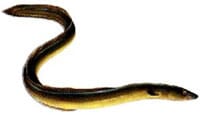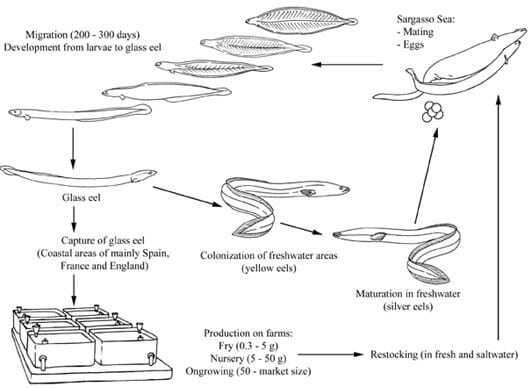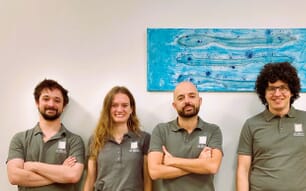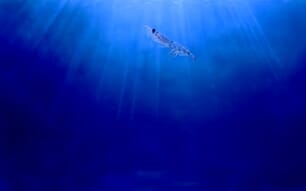Habitat and biology
The European eel is a catadromous and carnivorous species. Young eels live in freshwater, where they stay for a period of 6-12 years for males and 9-18 years for females. As the eels become sexually mature they migrate to the sea, where they move to the spawning grounds in the Sargasso Sea. During migration the eels do not feed.
Once in the Sargasso Sea the eels spawn in late winter and spring. Adult eels do not leave the Sargasso Sea but their progeny, the leaf-shaped larvae (leptocephali) are brought to the continental shelf of Europe by the Gulf Stream, a journey that takes 200-300 days.

Before entering coastal zones and estuaries the larvae metamorphose into transparent eels (glass eels). As the eels colonise the freshwater areas of Europe they are known as yellow eels (pigmented eels). During the last summer of their freshwater life, eels become sexually mature and silvery in appearance (silver eels). At this stage their eyes become bigger, their heads broader and the content of body fat increases.
The European eel is found in rivers draining into the North Atlantic, Baltic and Mediterranean Seas. It is also distributed along the coast of Europe from the Black Sea to the White Sea.
Production
Production Cycle

Production cycle of Anguilla anguilla
Production systems
Production of eels is based on wild catches of glass eels (elvers) used for further ongrowing. Extensive culture of European eels under natural conditions has diminished to a level of no commercial importance. Intensive production by the use of recirculation technology, keeping water temperatures stable around 24 °C, has become the overall production method.
Seed supply
Glass eels are captured around the shores of France, Portugal, Spain and the United Kingdom and either used nationally or exported to eel farmers in other countries. Some glass eel fishing in Spain and Portugal uses scoop nets and traps. In France they are caught by small trawlers using wing nets and trawls. The only legal fishing gear for this purpose in the UK is the scoop net.
Nursery
At first the glass eels (~0.33 g each) are kept in smaller tanks of 3-4 m² for quarantine purposes. The density at this stage is 10-15 kg/m². The eels are examined for diseases and, following diagnosis, treated. The eels are also weaned to artificial diets with cod roe and, later on, dry starter feed.
When the eels reach approximately 5 g they are transferred to a juvenile production unit with larger tanks (6-8 m²) and stocking densities (50-75 kg/m²). At this point the eels can digest dry feed pellets (1 mm).
Ongrowing techniques
Extensive pond systems
The traditional form of eel culture in Europe is in ponds of about 100-350 m². When eels reach marketable size they are transferred to larger ponds (1000-1500 m²). The ponds may be static or flow-through. The best temperature range in ponds is 18-25 °C.
Intensive culture in recirculation systems
These systems consist of square or circular tanks from 25-100 m², usually built of cement or fibreglass. The eels are stocked at a size of 50 g. Densities reach up to 100-150 kg/m². Extruded dry feed (1.5-3 mm) is fed automatically several times a day. Individual growth rates are very different, and grading every 6 weeks is necessary in order to reach a high overall growth performance.
Valliculture
Eels are also extensively cultured in marine and brackish waters within a form of aquaculture known as valliculture. In these Mediterranean systems, mainly in Italy, in the north Adriatic, elvers of 15-35 g are stocked at the rate of 4-15 kg/ha. The elvers are mainly imported from France but also from Denmark, the Netherlands and Sweden.
Feed supply
Almost all forms of intensive culture use formulated feeds in the form of a moist paste for glass eels and steam-pressed or extruded pellets for the later stages. Several European aquafeed manufacturers produce eel feeds.
Harvesting techniques
Partial harvesting and grading are important facets of successful eel farming. The actual technique used is simple but care is necessary to minimise stress. Feeding is stopped minimum 1-2 days before grading or harvesting. Eels are led passively through a pipe from the rearing tank to a grading machine. Eels large enough for the market are dealt with as indicated in the following section of this fact sheet. Eels that have not reached market size are returned to the rearing tanks for further ongrowing. During harvesting, care is taken to keep oxygen levels high.
Handling and processing
After harvesting, eels are rapidly sorted into different sizes, using grading systems. They are kept in holding tanks without feed for several days to purge their stomachs and eliminate possible off-tastes. If they are to be consumed fresh, they are chilled, packed into strong oxygenated plastic bags with just enough water to ensure that the skin remains moist, and transported to market. If they are destined for processing they are transported live to the processing plant. Most Danish farmed eels are smoked at Dutch processing plants, while a smaller part is skinned in Denmark for frying.
Production costs
The cost of elvers varies significantly depending on annual catches and the interest from Asian eel producers, who buy European eels for farming in their home countries. Prices during 2004 varied between 300.00 and 750.00 EUR/kg.
General over all production costs in recirculation systems of about 6.00 EUR/kg have been reported (2003) from Denmark.
Diseases and control measures
European eels are susceptible to numerous parasites, fungi, bacteria, and viruses that can cause disease outbreaks. However, in aquaculture only a few disease agents result in disease outbreaks that decrease growth or increase mortality. Commonly seen disease agents are listed in the following table.
In some cases antibiotics and other pharmaceuticals have been used in treatment but their inclusion in this table does not imply an FAO recommendation.
| DISEASE | AGENT | TYPE | SYNDROME | MEASURES |
|---|---|---|---|---|
| Red fin disease | Aeromonas hydrophila | Bacterium | Tail rot; fin rot; haemorrhagic septicaemia | Improved water quality; NaCl (0.5-0.9%) |
| Red eel pest | Vibrio anguillarum | Bacterium | Red spots on ventral & lateral areas; swollen & dark skin lesions that ulcerate | Antibiotics |
| Viral diseases (Red head) | Herpes & Rhabdoviruses | Viruses | Haemorrhages around the head and operculum initially; later spread to the whole body | Vaccination with infected fingerlings from preceding year; decreased temperature (18-20 °C); NaCl (0.1%) |
| Fungal infections | Saprolegnia spp. | Fungi | White to brown cottony or hairy patches on the skin, fins and gills; death may occur if gills obstructed; usually secondary infection. | NaCl (0.1%) |
| Dermocystidium anguillae | Sometimes classed as a protozoan but probably a fungus | Swellings on gills, fins or body | None - removal of infected eel | |
| Parasitic infections | Pseudodactylogyrus anguillae; P. bini | Monogeneans | Invade the gills; respiratory distress | Formaldehyde (24%) - 60 ppm; Mebendazole |
| Trichodina spp. | Ciliates | Flashing; lethargy; increased mucus production; sometimes ulcers and frayed fins; respiratory distress if gills affected | Formaldehyde (24%) - 60 ppm | |
| Ichthyophthirius multifiliis | Protozoan | White patches on body; becoming lethargic; attempt to remove parasites by rubbing on enclosure surfaces | NaCl (1%) |
November 2009




